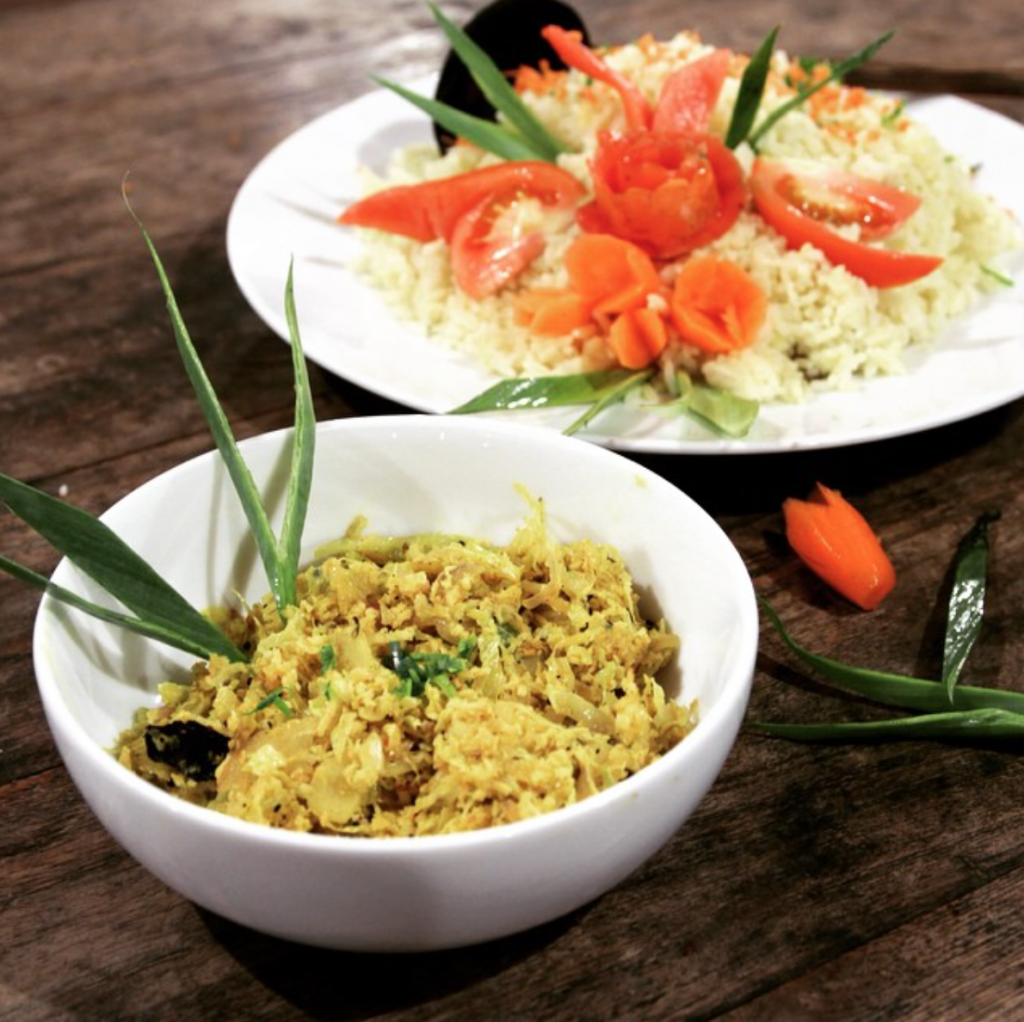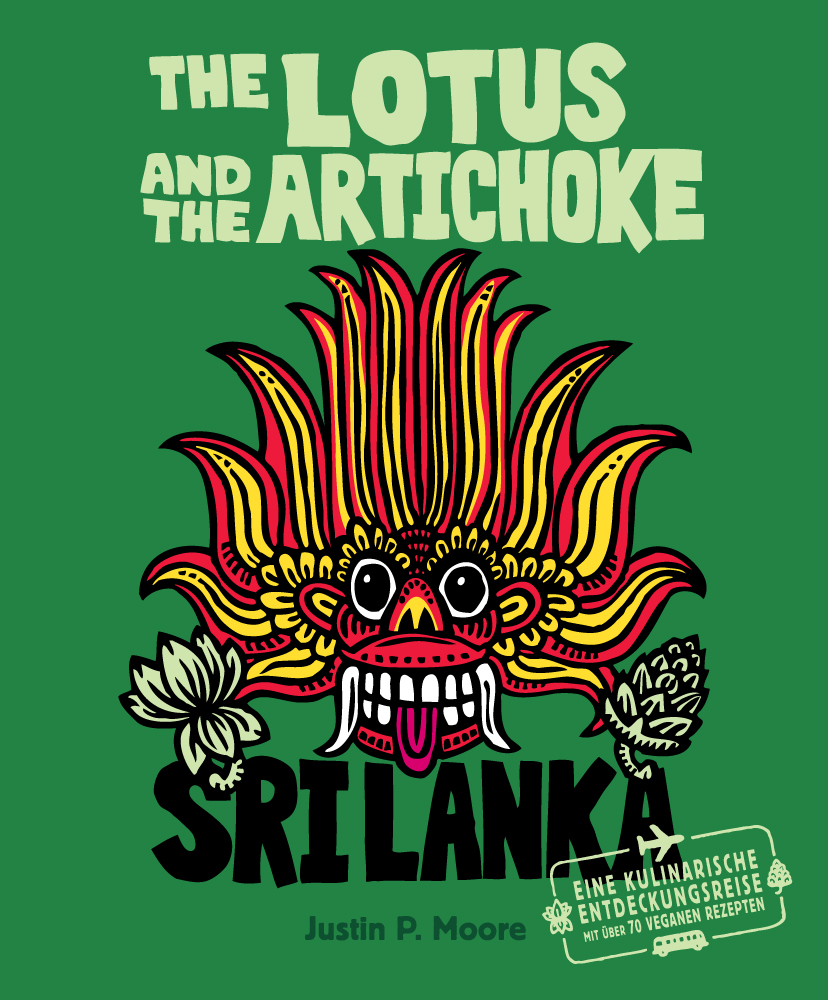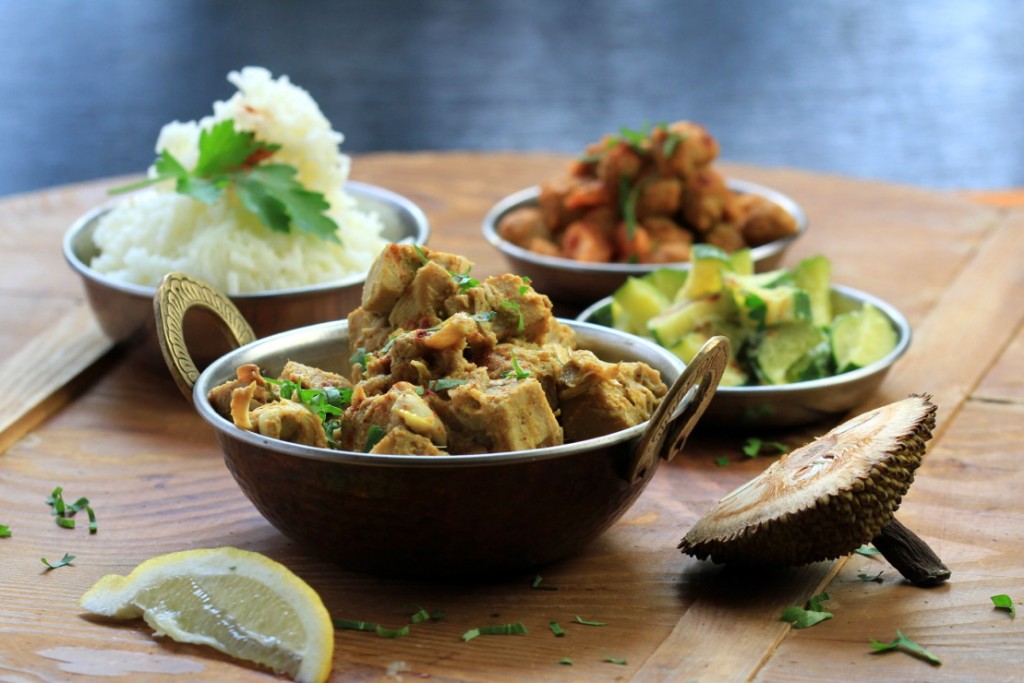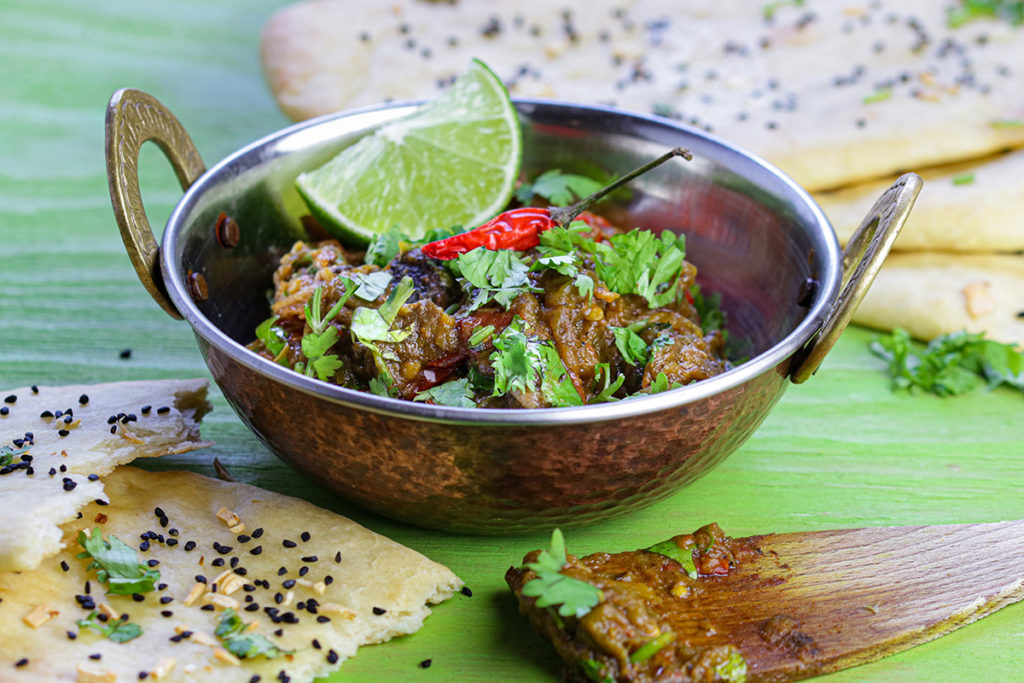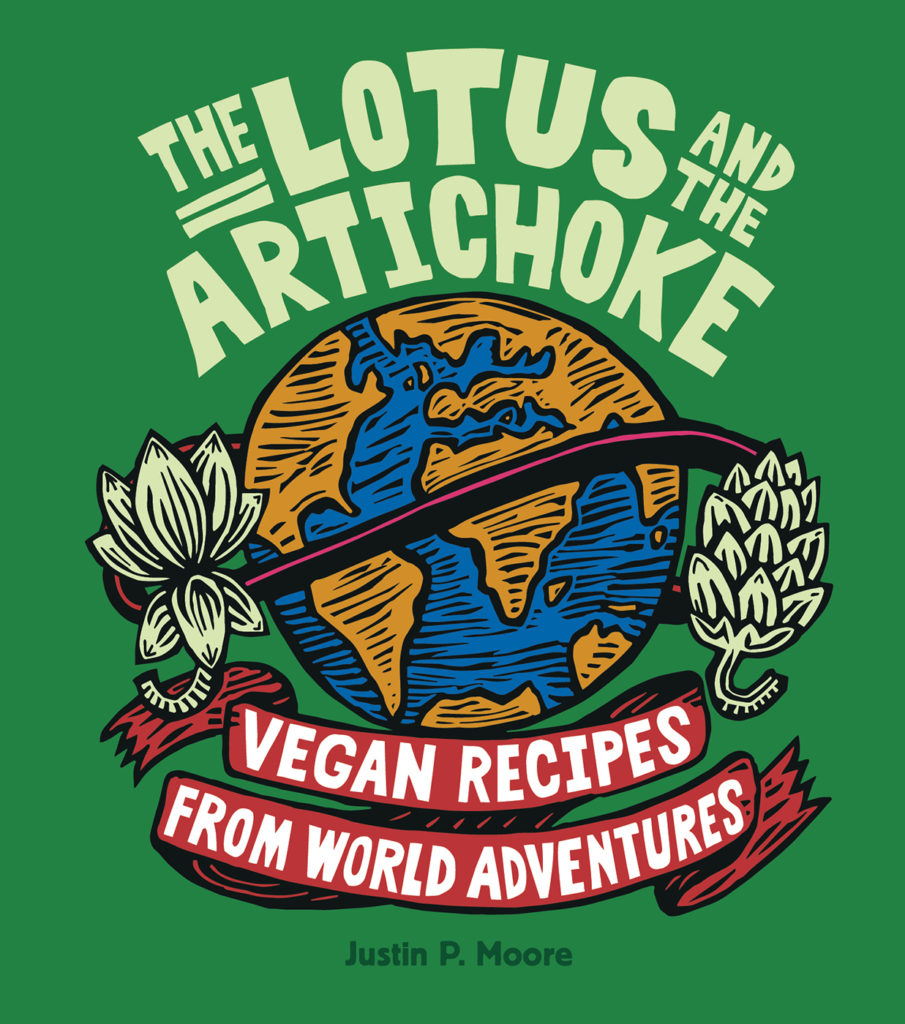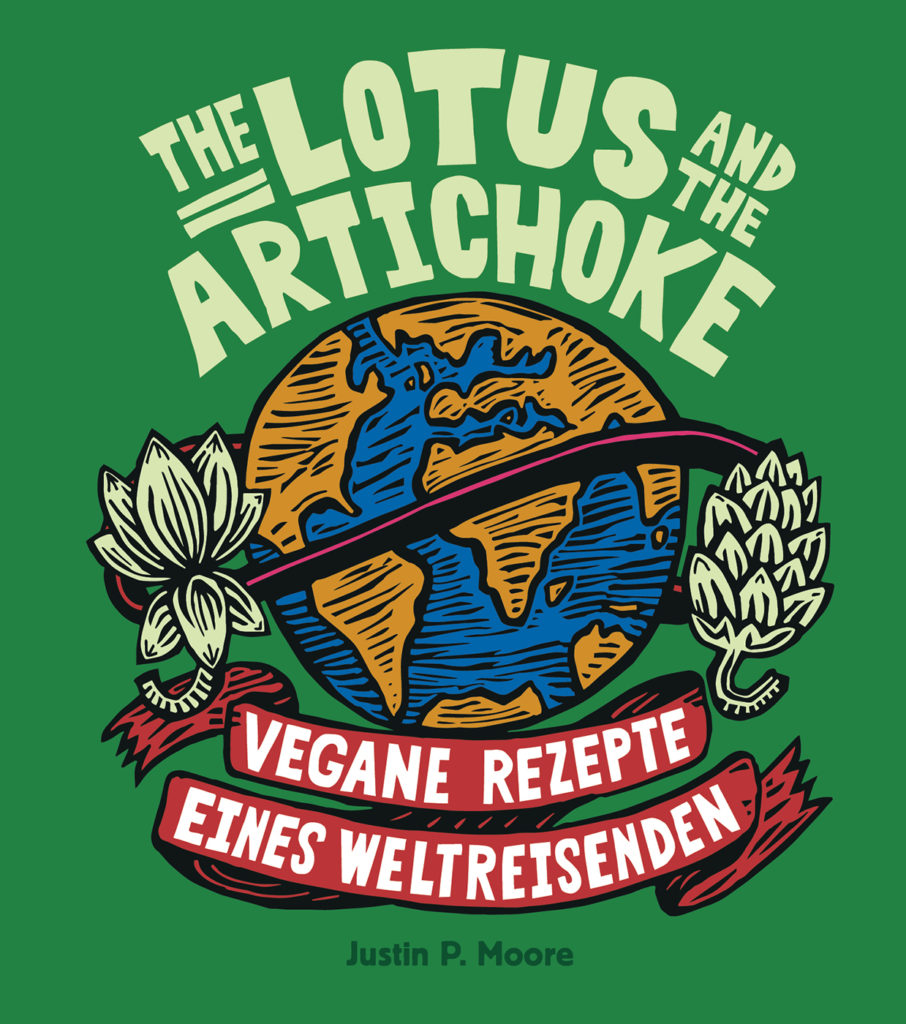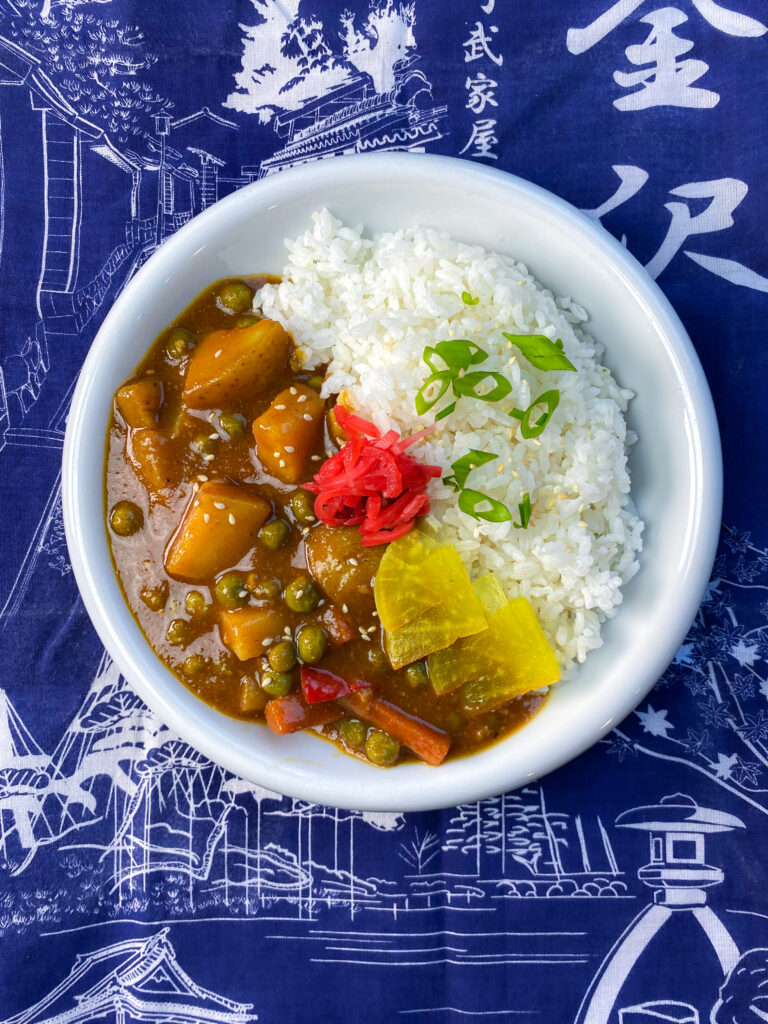
Kare Raisu
vegetable curry with rice
serves 4 / time 45 min
recipe from The Lotus and the Artichoke – JAPAN
(Rezept auf Deutsch unten)
- 2 medium (300 g) potatoes chopped
- 1 medium (135 g) carrot chopped
- 1 medium (100 g) onion chopped
- 3 cloves garlic crushed or minced
- 3/4 in (2 cm) fresh ginger minced
- 1 small (100 g) apple chopped
- 2 cups (480 ml) water
- 2 Tbs vegetable oil
- 8–10 curry leaves
- 1 Tbs cumin ground
- 1 Tbs coriander ground
- 1/2 tsp black pepper ground
- 1/2 tsp turmeric ground
- 1/4 tsp cinnamon ground
- 2 bay leaves
- 1 small black cardamom pod optional
- 1 red chili optional
- 1 Tbs tomato paste
- 1 Tbs peanut butter
- 3 Tbs shoyu (soy sauce)
- 1 tsp dark soy sauce
- 1 Tbs lemon juice or rice vinegar
- 1 Tbs sake optional
- 2 tsp raw sugar
- 1 tsp tamarind paste
- 1/2 tsp sea salt more as needed
- 1/4 cup (60 ml) hot water
- 2 Tbs vegan margarine
- 2 Tbs flour (all-purpose / type 550)
- 1 cup (125 g) green peas
- 5 cups (900 g) Gohan steamed rice (page 99)
- 2 Tbs Takuan pickled daikon (page 61) sliced
- 4 tsp Benishoga red pickled ginger (page 57)
- Heat vegetable oil in a large pot on medium heat.
- Add chopped onion. Cook, partially covered, until onion begins to soften, stirring often, 5–8 min.
- Add garlic, ginger, curry leaves, ground cumin, coriander, black pepper, turmeric, cinnamon, bay leaves, black cardamon, and red chili (if using). Fry, stirring often, until richly aromatic, 2–3 min.
- Add chopped potatoes and carrots. Stir to combine.
- Cook partially covered until vegetables start to soften, 6–8 min, adding 1–2 Tbs water if needed, stirring often.
- Blend chopped apple with 2 cups (480 ml) water until smooth. Gradually add this to vegetables in the large pot, stirring constantly. Bring to simmer and cook partially covered on medium low heat until vegetables are mostly soft, stirring regularly, 5–8 min.
- In a bowl, whisk tomato paste, peanut butter, shoyu, dark soy sauce, lemon juice or
rice vinegar, sake (if using), sugar, tamarind paste, salt, and 1/4 cup (60 ml) hot water. - Heat margarine in a small pot on medium low heat. Add flour and whisk until smooth.
Cook, stirring constantly, 1–2 min. - Gradually pour whisked tomato mixture into the small pot with the flour mixture.
Whisk until smooth. Return to simmer. Simmer on low, stirring constantly, for another 1–2 min. - Stir the thickened mixture into the large pot of vegetables. Return to simmer, stirring constantly.
- Stir in green peas.
- Return to simmer and continue to cook on low heat, stirring regularly, to desired consistency, adding some water and/or salt, as needed, 8–10 min. Remove from heat. Cover and let sit 10 min.
- Portion on plates with Gohan steamed rice. Garnish with sliced Takuan and Benishoga.
Variations:
Katsu Kare: Top curry with sliced Tofu Katsu (page 157) or Katsu (page 159).
Kare Raisu
Gemüse-Curry mit Reis
4 Portionen / Dauer 45 Min.
Rezept aus The Lotus and the Artichoke – JAPAN
- 2 mittelgroße (300 g) Kartoffeln gewürfelt
- 1 mittelgroße (135 g) Möhre gewürfelt
- 1 mittelgroße (100 g) Zwiebel gewürfelt
- 3 Knoblauchzehen fein gehackt
- 2 cm frischer Ingwer fein gehackt
- 1 kleiner (100 g) Apfel gehackt
- 2 Tassen (480 ml) Wasser
- 2 EL Pflanzenöl
- 8–10 Curryblätter
- 1 EL Kreuzkümmel gemahlen
- 1 EL Koriander gemahlen
- 1/2 TL schwarzer Pfeffer gemahlen
- 1/2 TL Kurkuma gemahlen
- 1/4 TL Zimt gemahlen
- 2 Lorbeerblätter
- 1 schwarze Kardamomkapsel wenn gewünscht
- 1 rote Chilischote gehacktwenn gewünscht
- 1 EL Tomatenmark
- 1 EL Erdnussbutter
- 3 EL Shoyu (Sojasauce)
- 1 TL dunkle Sojasauce
- 1 EL Zitronensaft oder Reisessig
- 1 EL Sake wenn gewünscht
- 2 TL Rohzucker
- 1 TL Tamarindenpaste
- 1/2 TL Meersalz bei Bedarf mehr
- 1/4 Tasse (60 ml) warmes Wasser
- 2 EL vegane Margarine
- 2 EL Mehl (Type 550)
- 1 Tasse (125 g) grüne Erbsen
- 5 Tassen (900 g) Gohan gedämpfter Reis (Seite 99)
- 2 EL Takuan eingelegter Daikon (Seite 61)
- 4 EL Benishoga eingelegter Ingwer (Seite 57)
- Pflanzenöl in einem großen Topf auf mittlerer Flamme erhitzen.
- Gewürfelte Zwiebel hinzufügen. Unter häufigem Rühren 5 bis 8 Min. braten, bis die Zwiebel weich wird.
- Knoblauch, Ingwer, Curryblätter, Kreuzkümmel, Koriander, schwarzen Pfeffer, Kurkuma, Zimt, Lorbeerblätter, Kardamom und roten Chili (falls verwendet) hinzufügen und 2 bis 3 Min. anbraten.
- Gewürfelte Kartoffeln und Möhre einrühren.
- Halb abgedeckt 6 bis 8 Min. kochen, bis das Gemüse weicher wird. Bei Bedarf 1–2 EL Wasser zugeben.
- Gehackten Apfel mit 2 Tassen (480 ml) Wasser im Mixer glatt pürieren. Zum Gemüse im Topf hinzufügen. Zum Kochen bringen und halb abgedeckt auf mittlerer Flamme 5 bis 8 Min. köcheln,
bis das Gemüse weich ist, dabei regelmäßig umrühren. - In einer Schüssel Tomatenmark, Erdnussbutter, Shoyu, dunkle Sojasauce, Zitronensaft oder Reisessig, Sake (falls verwendet), Zucker, Tamarindenpaste, Salz und 1/4 Tasse (60 ml) warmes Wasser verquirlen.
- Margarine in einem kleinen Topf auf mittlerer Flamme erhitzen. Mehl mit einem Schneebesen einrühren. 1 bis 2 Min. unter ständigem Rühren anbraten und glatt verrühren.
- Die verquirlte Tomatenmischung nach und nach in die Mehlmischung einrühren und aufkochen lassen. Auf niedriger Flamme unter Rühren 1 bis 2 Min. köcheln lassen.
- Die eingedickte Mischung unter das Gemüse rühren und wieder zum Kochen bringen.
- Grüne Erbsen unterrühren.
- Auf niedriger Flamme unter Rühren bis zur gewünschten Konsistenz 8 bis 12 Min. weiter köcheln. Nach Bedarf mehr Wasser und Salz einrühren. Vom Herd nehmen. Abdecken und 10 Min. stehen lassen.
- Auf Tellern mit Gohan (gedämpftem Reis) portionieren. Mit gehacktem Takuan und Benishoga garnieren.
Variationen:
Katsu Kare: Curry mit in Scheiben geschnittenem Tofu Katsu (Seite 157) oder Katsu (Seite 159) belegen.





